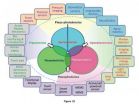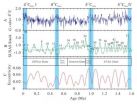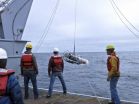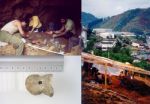(Press-News.org) Scientists at Chicago's Field Museum and international collaborators have reconstructed the phylogeny and biological history for the Yellow-shouldered bats in the New World tropics, the region of the Earth surrounding the equator. In-depth analysis of mitochondrial and nuclear DNA sequences uncovered three species new to science, each having previously been confused with another species. Since 1960, when modern studies on this group began, Sturnira has grown from eight species to 22. The newest additions were described in a new study, published online in ZooKeys.
The New World tropics have long been recognized as a region teeming with some of the richest biodiversity on Earth. It is home to a group of small, fruit-eating bats ranging from half-an-ounce to three ounces in size. The bats belong to the genus Sturnira, commonly named yellow-shouldered bats, which are found from northern Mexico to northern Argentina. One species in particular, Sturnira lilium, has figured among the most widespread and locally abundant bats of the New World topics.
"A curator's job is to bring order out of chaos," said Bruce Patterson, PhD, MacArthur Curator of Mammals at The Field Museum. "This group of bats offered an excellent opportunity study the process of species formation across the entire New World tropics."
Paúl Velazco, PhD, who formerly worked at The Field Museum and now is with the American Museum of Natural History in New York, is the lead author on the new study. Velazco and Patterson began their endeavor by collecting 38 samples of six species from three countries. They also borrowed 94 samples from 24 countries from museums around the world in order to complete the project, highlighting the importance of museum collections for the growing body of scientific knowledge.
The researchers isolated DNA from a small portion of liver or muscle samples that had been frozen or preserved from each specimen. They then amplified and sequenced two nuclear and three mitochondrial genes from each tissue, amounting to nearly 5,000 base pairs of DNA, from over 120 individuals.
"We chose these genes because they have proven useful for classification of related groups of bats," said Velazco. "Mitochondrial sequences tend to be fast-evolving and informative about very recent evolutionary splits, while nuclear genes tend to be slow-evolving and shed light on more ancient divergence events."
By sequencing both classes of DNA, the researchers could recover the group's entire history, which stretches back about 8 million years.
Every museum specimen that was sequenced already had both a name and a geographic distribution. However, the sequence analysis led the investigators to believe that some of the branch labels were incorrect. Indeed, after re-examining the museum specimens associated with each sample, they found that nearly 20 percent of the specimens had been incorrectly labeled!
How could so many individual animals have been misidentified? The answer lies within technology.
"The differences between species are often subtle, and difficult to describe in writing. The historic literature lacked access to the visual documentation that we rely on today, such as color photography and digital libraries," said Patterson. "For this reason, small and imprecisely described morphological differences were often overlooked during the original identification of the specimens. This type of error pervades all biological collections."
Their results identified three species entirely new to science, and provided evidence for the elevation of three subspecies to the species level. Two of the new species are described in the ZooKeys article.
In the process, Velazco and Patterson were able to revise the supposed geographic range of Sturnira lilium. Instead of extending from Mexico to Argentina, the real Sturnira lilium is limited to Bolivia, Brazil, Paraguay, Uruguay, and northern Argentina. The rest of its presumed range is occupied by six other close relatives that replace one another in jigsaw-like fashion across the Neotropics.
The distribution of Sturnira species across most of the New World tropics and its diversification throughout its eight-million-year existence make it informative for other sorts of biological reconstructions, such as the seed plants upon which it feeds.
In addition to its scientific usefulness, this study demonstrates the need for the ongoing revision of the Earth's biological history, and highlights the immense value of museum collections in uncovering new knowledge.
"For this particular group of mammals, we are much closer that we were in framing their diversity, although there may be additional Sturnira out there," said Patterson. "Over the years, I've learned that no one has the last word in science."
INFORMATION:
Contact information for Paúl M. Velazco:
(212) 313-7920
pvelazco@amnh.org
Three new species of yellow-shouldered bats discovered in museum collections
2014-04-14
ELSE PRESS RELEASES FROM THIS DATE:
Ex vivo efficacy of C1s antibody as Complement inhibitor in cold agglutinin disease
2014-04-14
SOUTH SAN FRANCISCO, Calif.--True North Therapeutics, Inc., announced today a publication demonstrating that the company's C1s antibody prevents the destruction of human red blood cells exposed to plasma samples of patients with a type of autoimmune hemolytic anemia (AIHA). The article entitled "TNT003, an inhibitor of the serine protease C1s, prevents complement activation induced by cold agglutinin disease patient autoantibodies" was published on-line in the journal Blood earlier this month. TNT003 is the murine analog of True North's lead humanized monoclonal antibody ...
Neuroscientists: Brain activity may mark the beginning of memories
2014-04-14
By tracking brain activity when an animal stops to look around its environment, neuroscientists at the Johns Hopkins University believe they can mark the birth of a memory.
Using lab rats on a circular track, James Knierim, professor of neuroscience in the Zanvyl Krieger Mind/Brain Institute at Johns Hopkins, and a team of brain scientists noticed that the rats frequently paused to inspect their environment with head movements as they ran. The scientists found that this behavior activated a place cell in their brain, which helps
the animal construct a cognitive map, ...
Piezotronics and piezo-phototronics leading to unprecedented active electronics and optoelectronics
2014-04-14
New technologies for developing electronics and optoelectronics with tunable/adaptive functionalities and performance are critical to emerging applications in wearable technology, communication, pervasive computing, human-machine interfacing and biomedical diagnostics, in which the active and adaptive interactions between devices and stimuli from the ambient/host (e. g. human body) are essential. Mechanical stimuli are ubiquitous and abundant in the environment for interacting with or controlling these electronics/optoelectronics. This is, however, not facile to implement ...
Quantum manipulation: Filling the gap between quantum and classical world
2014-04-14
Quantum superposition is a fundamental and also intriguing property of the quantum world. Because of superposition, a quantum system can be in two different states simultaneously, like a cat that can be both "dead" and "alive" at the same time. However, this anti-intuitive phenomenon cannot be observed directly, because whenever a classical measuring tool touches a quantum system, it immediately collapse into a classical state. On the other hand, quantum superposition is also the core of quantum computer's enormous computational power. A quantum computer can easily break ...
New Commission study identifies Europe's top ICT hubs
2014-04-14
Wondering what makes an ICT hotspot? Take a look at Munich, London, Paris or smaller cities such as Darmstadt identified in a new EU Atlas of ICT hotspots. This atlas shows where digital technologies thrive and examines the factors contributing to this success.
Most of Europe's ICT activity takes place in 34 regions across 12 countries (listed in the Annex). Key ingredients to success included access to top Universities and research centres and funding opportunities such as venture capital.
European Commission Vice-President @NeelieKroesEU said: "This is proof that ...
Climate change: The role of oceanic carbon reservoir over glacial cycles
2014-04-14
Glacial cycles at 104-yr time scale have been the focus of Quaternary paleoclimatology over the last century. In recent years with the emergence of continuous high-resolution records (ice cores, deep-sea sediments etc.) from the longer geological past, increasing evidence underscores the significance of long- duration processes at the time scale of 105-yr or more. WANG Pinxian and colleagues from the State Key Laboratory of Marine Geology, Tongji University, reviewed long-term variations in the oceanic carbon reservoir and indicated their crucial role in major climate regime ...
Genetically modified tobacco plants as an alternative for producing bioethanol
2014-04-14
Tobacco, a high-density crop which is mown several times throughout its cycle, can produce as much as 160 tonnes of fresh matter per hectare and become a source of biomass suitable for producing bioethanol. As Jon Veramendi, head of the plant Agrobiotechnology research group, explained, "tobacco plants as a source of biomass for producing bioethanol could be an alternative to traditional tobacco growing which is in decline in the USA and in Europe because it cannot compete with emerging countries like China".
In the course of the research, which has been echoed by the ...
Puget Sound's rich waters supplied by deep, turbulent canyon
2014-04-14
The headwaters for Puget Sound's famously rich waters lie far below the surface, in a submarine canyon that draws nutrient-rich water up from the deep ocean. New measurements may explain how the Pacific Northwest's inland waters are able to support so many shellfish, salmon runs and even the occasional pod of whales.
University of Washington oceanographers made the first detailed measurements at the headwater's source, a submarine canyon offshore from the strait that separates the U.S. and Canada. Observations show water surging up through the canyon and mixing at surprisingly ...
Study links domestic abuse to mental health problems in new mothers
2014-04-14
A new study shows that domestic abuse is closely linked to postpartum mental health problems, including depression and post-traumatic stress disorder (PTSD), in mothers. The research also found that specific types of abuse are associated with specific mental health problems. The work was done by researchers at North Carolina State University, Simon Fraser University and the University of British Columbia.
"We wanted to see whether and how intimate partner abuse – physical, psychological and sexual – influenced postpartum mental health in women, including problems such ...
Neanderthals and Cro-magnons did not coincide on the Iberian Peninsula
2014-04-14
This news release is available in Spanish. Until now, the carbon 14 technique, a radioactive isotope which gradually disappears with the passing of time, has been used to date prehistoric remains. When about 40,000 years, in other words approximately the period corresponding to the arrival of the first humans in Europe, have elapsed, the portion that remains is so small that it can become easily contaminated and cause the dates to appear more recent. It was from 2005 onwards that a new technique began to be used; it is the one used to purify the collagen in DNA tests. ...




